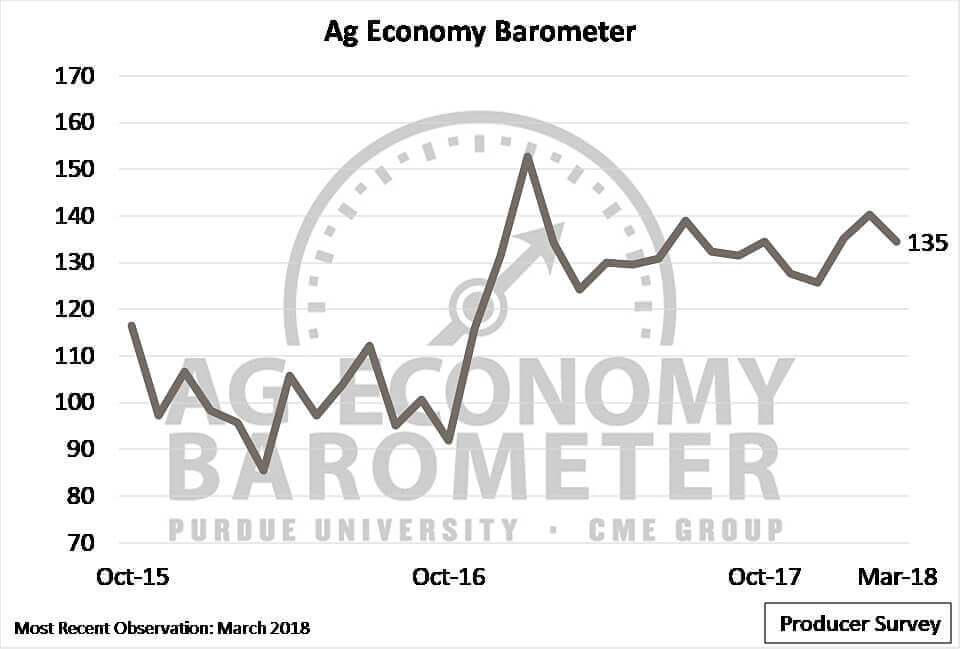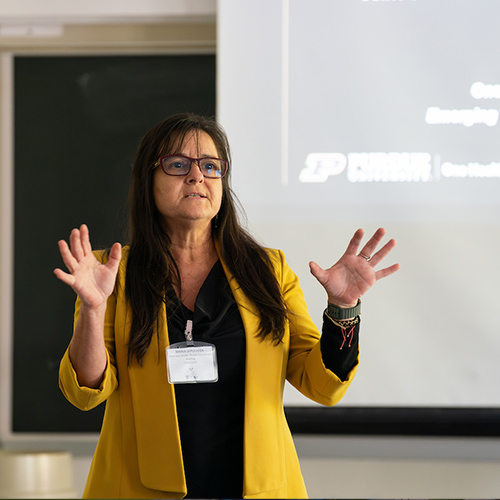Sentiment falls as producers express concerns about ag exports
The Purdue University/CME Group Ag Economy Barometer fell to 135 in March, given uncertainty around trade relations and possible implications for U.S ag exports.
The 5-point decline in sentiment comes as a result of producers’ less-optimistic perceptions of both current conditions and future expectations. The Index of Current Conditions fell 9 points in March to 134, while the Index of Future Expectations dropped by 4 points to 135. The barometer and both sub-indices are based on a monthly survey of 400 U.S. agricultural producers.
On the March survey, producers expressed both concern and uncertainty surrounding trade. Nearly half (47 percent) of respondents said that a trade war negatively impacting agricultural exports was somewhat likely, compared with just 28 percent who thought it was unlikely. The remaining 25 percent indicated uncertainty with a neutral rating.
Producers also were asked about the likelihood of a U.S. withdrawal from the North American Free Trade Agreement (NAFTA). More than one-third expressed uncertainty, while 28 percent expected the U.S. to remain in NAFTA and 34 percent said they expect the U.S. to exit the agreement.
“Interestingly, when comparing results from the two trade questions, a larger share of respondents reported a significant decline in agricultural exports from a trade war was more likely than the U.S. withdrawing from NAFTA,” said James Mintert, director of Purdue University’s Center for Commercial Agriculture and principal investigator on the barometer project. “These results are important for two reasons. First, nearly half of producers rated the risk of a trade war as at least somewhat likely. Second, producers’ concerns about risks to agricultural trade are broader than just the ongoing NAFTA situation.”
The March survey also asked producers whether they thought now was a good time to make large farm investments, such as machinery or buildings. At 68 percent, the portion of producers indicating now is a bad time to make large investments is the highest level observed since May 2017. Mintert said this could be related to the trade situation.
“Concerns about agricultural exports, especially as they relate to Chinese tariffs on U.S. ag products, could be one reason why fewer producers said now is a good time to make large farm investments,” he said.
Read the full March Ag Economy Barometer report at http://purdue.edu/agbarometer. The Ag Economy Barometer, Index of Current Conditions and Index of Future Expectations are available on the Bloomberg Terminal under the following ticker symbols: AGECBARO, AGECCURC and AGECFTEX.
About the Purdue University Center for Commercial Agriculture
The Center for Commercial Agriculture was founded in 2011 to provide professional development and educational programs for farmers. Housed within Purdue University’s Department of Agricultural Economics, the center’s faculty and staff develop and execute research and educational programs that address the different needs of managing in today’s business environment.
About CME Group
As the world’s leading and most diverse derivatives marketplace, CME Group (www.cmegroup.com) enables clients to trade futures, options, cash and OTC markets, optimize portfolios, and analyze data – empowering market participants worldwide to efficiently manage risk and capture opportunities. CME Group exchanges offer the widest range of global benchmark products across all major asset classes based on interest rates, equity indexes, foreign exchange, energy, agricultural products and metals. The company offers futures and options on futures trading through the CME Globex® platform, fixed income trading via BrokerTec and foreign exchange trading on the EBS platform. In addition, it operates one of the world’s leading central counterparty clearing providers, CME Clearing. With a range of pre- and post-trade products and services underpinning the entire lifecycle of a trade, CME Group also offers optimization and reconciliation services through TriOptima, and trade processing services through Traiana.
CME Group, the Globe logo, CME, Chicago Mercantile Exchange, Globex, and E-mini are trademarks of Chicago Mercantile Exchange Inc. CBOT and Chicago Board of Trade are trademarks of Board of Trade of the City of Chicago, Inc. NYMEX, New York Mercantile Exchange and ClearPort are trademarks of New York Mercantile Exchange, Inc. COMEX is a trademark of Commodity Exchange, Inc. BrokerTec, EBS, TriOptima, and Traiana are trademarks of BrokerTec Europe LTD, EBS Group LTD, TriOptima AB, and Traiana, Inc., respectively. Dow Jones, Dow Jones Industrial Average, S&P 500, and S&P are service and/or trademarks of Dow Jones Trademark Holdings LLC, Standard & Poor’s Financial Services LLC and S&P/Dow Jones Indices LLC, as the case may be, and have been licensed for use by Chicago Mercantile Exchange Inc. All other trademarks are the property of their respective owners.






